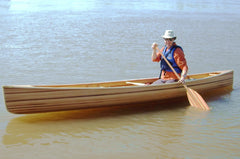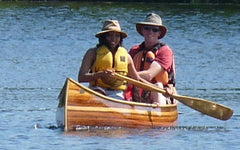Building Bluebird by Dawne Olson, Vermillion, SD, USA
Posted on May 15 2014

By Dawne Olson
Late in September of 2009 I was headed to Algonquin’s Lake Opeongo to canoe when a sudden violent rainstorm forced me to pull over in Peterborough, Ontario. When the wind and rain subsided I found myself in the parking lot of the Canadian Canoe Museum. What better way to pass the time while the foul weather cleared? The museum is a canoeist’s wonderland. During our visit I caught a glimpse into a shop area where several canoes were in various stages of construction. Seeing those wooden boats was a revelation. Up until that moment I don’t think I had seen or thought about the existence of cedar strip canoes. I bought my first canoe, an 18’ aluminum Osagian, for $200 at a pawn shop in Yankton, South Dakota 10 years earlier. In my limited experience there were only two kinds of canoes: aluminum and plastic. I was smitten by the beauty of those wooden boats in Peterborough. When I found Ted Moores book, Canoecraft, in the gift shop, I had to buy it. A few weeks later on a 3 hour drive to Lincoln, Nebraska for a Cornhuskers football game, I read the book from cover to cover. On the way home I read it again. Near the end of the trip I said to everyone in the van, “I think I am going to build a canoe.” They actually laughed at me but I knew I had to try.
I wanted to build something simple before I committed to the canoe. I needed to familiarize myself with a few power tools so my first project was to build saw horses. This small exercise taught me the difference between various types of saws. I learned about kerf and TPI and “binding” and “kickback”. It took me all weekend to build those saw horses. The first one wasn’t pretty but the second one was perfect. I looked at them and decided I was up to the task of cutting boards for the strongback. Once that was built I knew there was no turning back. I sold my aluminum canoes so that I could buy lumber and tools. I printed Ted Moores’s words from Canoecraft on a piece of poster board and taped it to the water heater in our basement where I had decided to build: “It pays to be naïve: a person can do a lot when they don’t know any better.” I had cut all the strongback pieces and the forms for the canoe with a jig saw and circular saw. I was ready to rip the cedar strips to build the canoe but I needed a table saw for that! I bought a table saw and spent all evening reading the owner’s manual. I couldn’t believe how scared I was to turn that saw on. Before I went out to the shop to attempt my first cut I asked my husband if he had any words of advice. He said, “Keep a cup of ice nearby for when you cut a finger off.”
Everywhere I went, Canoecraft went with me: the lumber yard, the hardware store, the marine supply stores. I bought chisels, block planes, clamps, glue, screws and other various supplies mentioned in the book. No one had ever heard of a cabinet scraper so I ordered it online. I decided to build without staples so every morning before work and every evening after work I would head down to the basement and add a few more strips to the forms. Christmas came and went and it was time to add the stems. I relied on the Bear Mountain builder’s forum for advice during this time and finally one of the guys said “how about I just call you”. He got on the phone with me and explained what a mortise was. I couldn’t believe I had to chisel a gouge into the hull of my boat. I thought it would be a disaster, but once the work started I began to ‘find my groove’ (pardon the pun) and chiseling the mortise for the stems ended up being one of my favorite stages of the building process.
January of 2010 was bitter cold and snow was piled high and deep outside. The basement of our 100 year old farmhouse was drafty and prone to visitors of the reptilian kind. When it came time to do the fiberglass layup on the canoe, it was everything I could do to keep the basement warm enough for the epoxy to cure. I ran space heaters around the clock for a couple weeks. By the time March rolled around I was under the gun to finish up the gunnels and thwarts so that the canoe would be rigid enough to move out of the basement. When the snow melted our basement would flood as it did every Spring. Water started to seep in and the sump pump chugged to keep pace. I became anxious and broke both inwales and had to re-make them. At one point I was tying power cords to the ceiling with zip ties and slogging through 4 inches of water in rubber boots while I installed gunnels, decks and a thwart.
Finally the day came when my canoe could leave the basement… Almost! In calculating the amount of space I would need to get through the doorway of our basement I had not allowed for the beam width! My husband and son helped me remove the door trim. It still didn’t fit. We beat out the bricks of the basement over the door opening and cut through re-bar in the concrete foundation of the house. After a tense couple hours the canoe was out. I moved everything to a loft over our garage and sanded and varnished the canoe, finished weaving the cane seats and hung them and plugged screw holes. The canoe was finished! I honestly could not believe how incredible it looked. On April 21st of 2010 we christened her “Bluebird” and took her on her maiden voyage in a nearby lake. There are no words to describe how it felt to set her down on the water for the first time. The rest of that year I took the canoe to over a dozen other lakes. Not only is she a stunning boat to look at but a real work horse too! I took her to Voyageurs National park with quite a load and she handled it beautifully. Other bodies of water that we paddled were the Mississippi headwaters at Itasca state park, the Missouri river, and a small jaunt along Lake Superior’s North Shore.
I’m often asked, “What made you decide to build a canoe?” Mostly it’s because I love canoes and paddling to beautiful places. Another reason is that there has always been an undercurrent of fear about being on the water since a near tragic boating incident in my childhood. Building my own canoe was in some way a rebellion against that fear. When I started the project it seemed so overwhelming and impossible but as the weeks went by and I sanded, sealed and strengthened my little vessel I grew confident that she would be a safe and reliable craft.
Ultimately I know this: no matter where that canoe takes me – near or far, alone or in the company of another paddler, when I set her down on the water and hear that familiar clapping of waves against her cedar strip hull, there is nothing in the world that feels as right as that!










